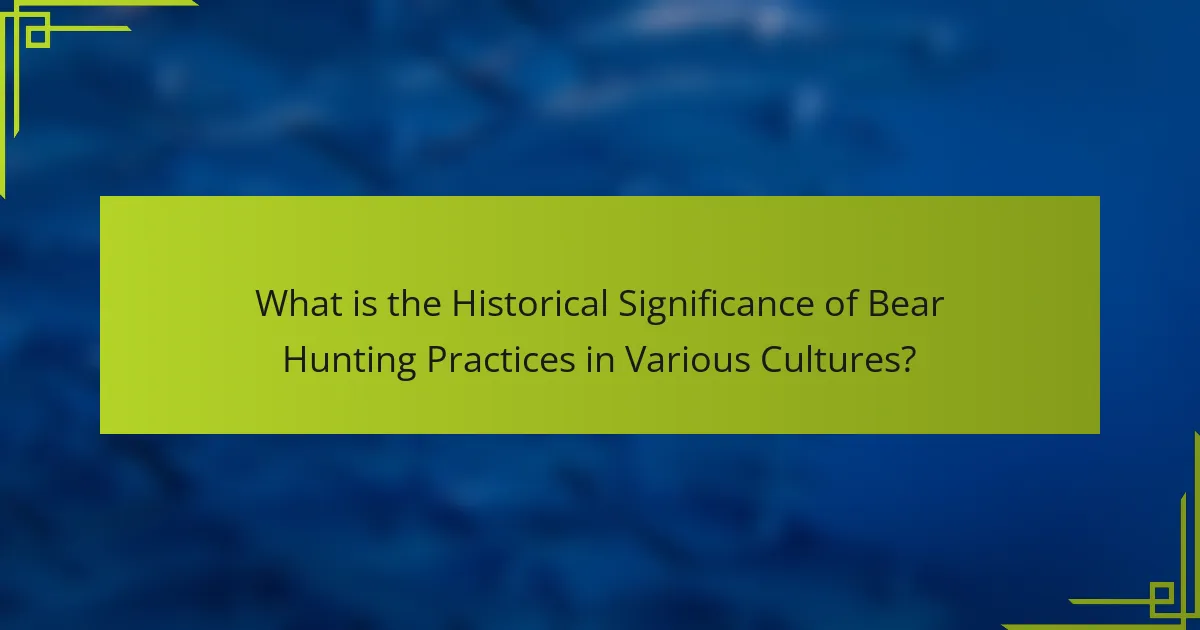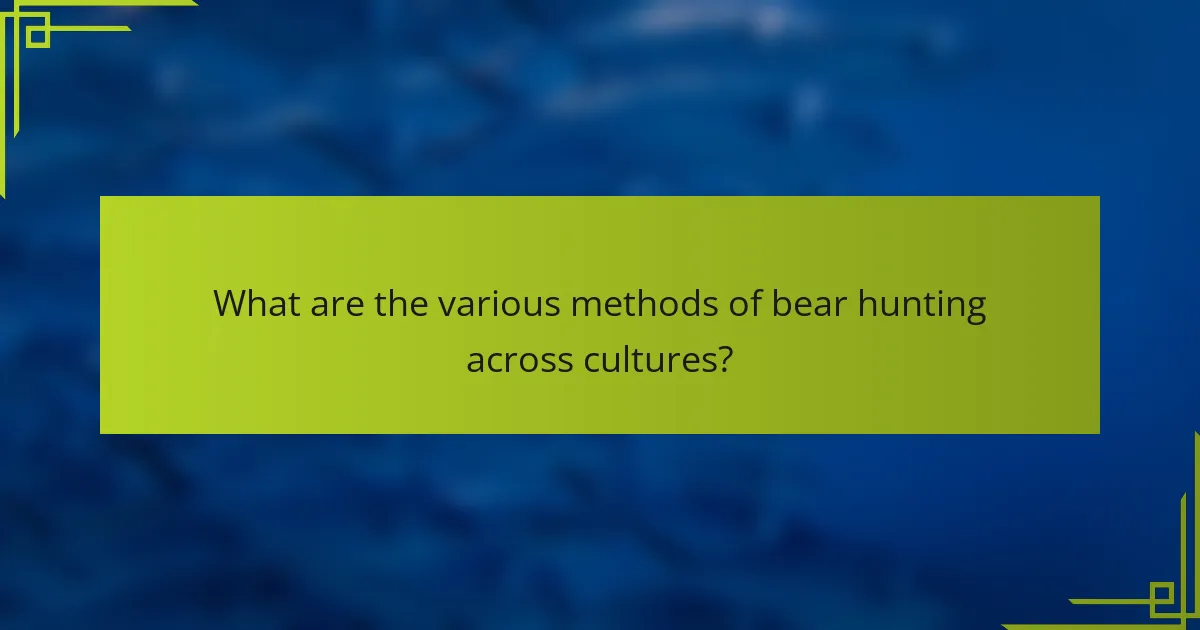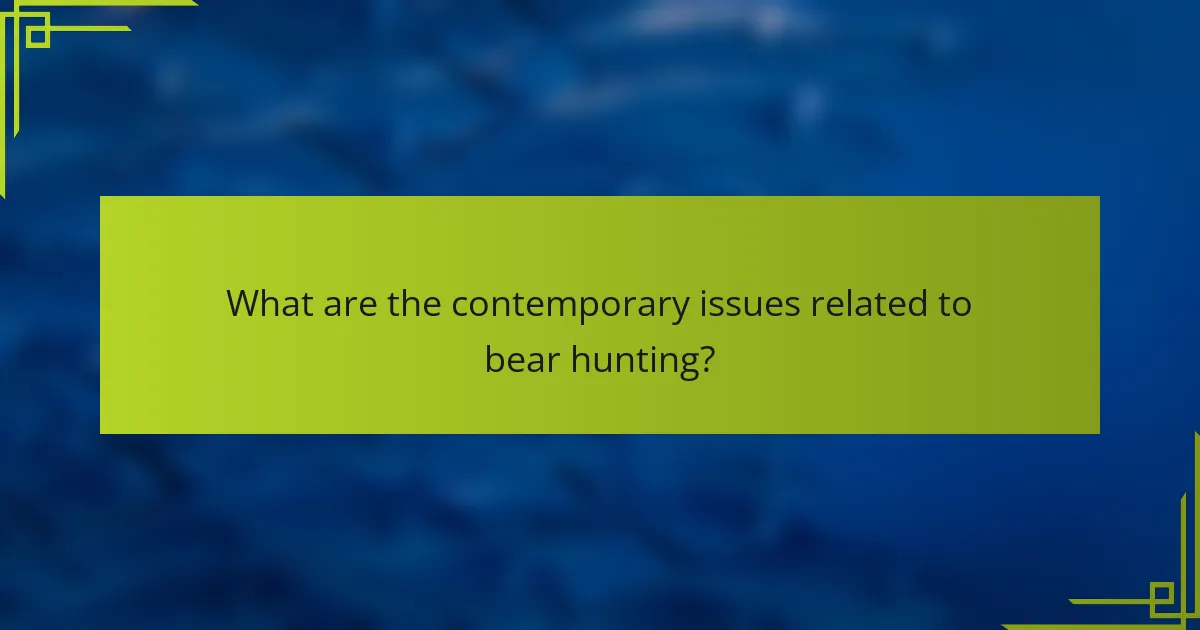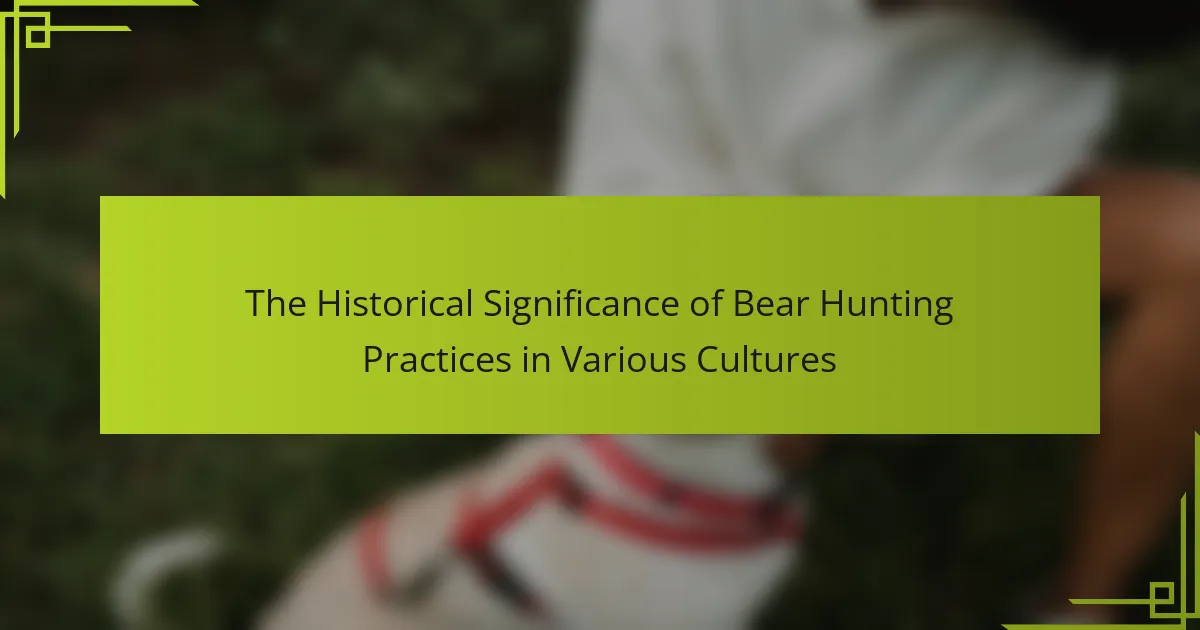Bear hunting practices are significant across various cultures due to their historical role in survival, social structure, and spiritual beliefs. Indigenous peoples, such as the Inuit and Native American tribes, have relied on bears for food, clothing, and tools, while also viewing them as powerful symbols in mythology. These practices foster community cohesion through cooperative hunting efforts and rituals that celebrate successful hunts. Additionally, bear hunting methods vary widely, reflecting cultural values and ecological knowledge, and contemporary issues include ethical concerns, conservation challenges, and regulatory debates surrounding hunting practices. The article explores these diverse aspects of bear hunting, highlighting its importance in human experience and cultural heritage.

What is the Historical Significance of Bear Hunting Practices in Various Cultures?
Bear hunting practices hold historical significance across various cultures for their role in survival, [censured], and social structure. In many indigenous cultures, bear hunting was essential for obtaining food, clothing, and tools from the animal’s body. The Inuit, for instance, relied on bears for sustenance in harsh Arctic environments.
Additionally, bear hunting often carried spiritual significance. Many cultures viewed bears as powerful symbols in their mythology. For example, in Native American traditions, bears represent strength and courage, and hunting them was seen as a rite of passage.
Socially, bear hunting has fostered community cohesion. It often involved cooperative efforts, strengthening bonds among hunters. In some cultures, successful hunts were celebrated with rituals and feasts, reinforcing social hierarchies and cultural identity.
Historically, bear hunting practices have also influenced art and storytelling. Many cultures depicted bears in their folklore, reflecting their importance in human experience. This cultural representation underscores the deep connection between humans and bears throughout history.
How have bear hunting practices evolved over time?
Bear hunting practices have evolved significantly over time. Early hunting was often a subsistence activity. Indigenous cultures relied on bear meat for food and used bear fat for fuel. Traditional methods included using traps and spears, emphasizing skill and knowledge of bear behavior. With the advent of firearms in the 19th century, hunting became more efficient. Regulations began to emerge in the 20th century to manage bear populations. Today, bear hunting practices are influenced by conservation efforts and ethical considerations. Modern hunters often engage in regulated hunting to ensure sustainability. The evolution reflects changes in technology, societal values, and wildlife management.
What are the key historical milestones in bear hunting?
Key historical milestones in bear hunting include the development of tools and techniques used by early humans. The earliest evidence of bear hunting dates back to the Paleolithic era, around 30,000 years ago. Archaeological findings show that prehistoric people used stone tools for hunting. In ancient cultures, bear hunting was often linked to rituals and spiritual beliefs. The use of bows and arrows in bear hunting became prominent around 2000 BC. In the Middle Ages, bear baiting emerged as a popular sport in Europe. The introduction of firearms in the 16th century revolutionized bear hunting practices. In the 19th century, bear hunting became a symbol of rugged individualism in American culture. Today, bear hunting is regulated to ensure sustainable populations and ethical practices.
How do these milestones reflect cultural changes?
Milestones in bear hunting practices reflect significant cultural changes by illustrating shifts in societal values and survival strategies. Historical evidence shows that early hunting practices were primarily driven by subsistence needs. As societies evolved, bear hunting transitioned into a symbol of cultural identity and heritage. For example, indigenous cultures often incorporated bear hunting into spiritual rituals, emphasizing a connection to nature. In contrast, modern practices may prioritize conservation and ethical hunting, reflecting changing attitudes toward wildlife. The evolution of hunting regulations further demonstrates cultural shifts, as communities adapt to ecological concerns and sustainability. These milestones serve as markers of how human interactions with nature have transformed over time.
Why is bear hunting important in different cultures?
Bear hunting is important in different cultures for various reasons. It serves as a traditional practice that connects communities to their ancestral heritage. In many indigenous cultures, bear hunting is a rite of passage and symbolizes strength and bravery. It also provides essential sustenance, as bear meat is a significant food source in some regions.
Additionally, bear hunting plays a role in ecological balance by managing bear populations. Cultural rituals surrounding bear hunting often include spiritual elements, honoring the animal and its spirit. For example, some cultures believe that hunting bears brings good fortune and prosperity.
Historical accounts show that bear hunting has been practiced for thousands of years, with evidence found in ancient cave paintings and artifacts. This demonstrates its long-standing significance in human history and cultural identity.
What roles does bear hunting play in indigenous cultures?
Bear hunting plays a significant role in indigenous cultures as a source of sustenance, spiritual practice, and cultural identity. It provides essential food resources, with bear meat being a vital part of the diet in many communities. The practice is often accompanied by rituals that honor the bear, reflecting respect for nature and its creatures.
Additionally, bear hunting is intertwined with traditional knowledge and skills passed down through generations. It fosters community bonding as hunts are frequently collective efforts involving families and clans. The cultural narratives surrounding bear hunting contribute to the identity of indigenous peoples, reinforcing their connection to the land and ancestral traditions.
Historical accounts, such as those from the Native American tribes of the Pacific Northwest, illustrate these practices and their importance in maintaining cultural heritage. Overall, bear hunting is not just a means of survival but a profound expression of indigenous cultural values and beliefs.
How does bear hunting influence social structures within communities?
Bear hunting influences social structures within communities by fostering cooperation and shared cultural practices. It often requires teamwork during hunts, strengthening bonds among participants. This collaboration can lead to the establishment of social hierarchies based on hunting skills or experience. Communities may develop rituals and traditions surrounding bear hunting, enhancing cultural identity.
For example, among Indigenous peoples, bear hunting is integral to their cultural heritage and community cohesion. It promotes the sharing of resources, as successful hunts often lead to communal feasts. Additionally, bear hunting can serve as a rite of passage, marking the transition of individuals into adulthood.
Research indicates that such practices can reinforce community values and social roles. In some cultures, the successful hunt is celebrated through festivals, further solidifying social ties. Overall, bear hunting plays a significant role in shaping social dynamics and cultural identity within communities.
What ethical considerations surround bear hunting practices?
Ethical considerations surrounding bear hunting practices include animal welfare, ecological impact, and cultural significance. Animal welfare concerns arise from the methods used to hunt bears, which can cause suffering. Ecological impact relates to the balance of ecosystems, as overhunting can threaten bear populations and biodiversity. Cultural significance often involves indigenous practices where hunting bears is a traditional activity with spiritual meaning. Studies show that sustainable hunting practices can maintain bear populations while respecting cultural traditions. The International Union for Conservation of Nature emphasizes the importance of ethical hunting guidelines to ensure conservation and animal welfare.
How do cultural beliefs shape attitudes towards bear hunting?
Cultural beliefs significantly influence attitudes towards bear hunting. In many indigenous cultures, bears are viewed as sacred animals. These beliefs often lead to respectful hunting practices that honor the bear’s spirit. For example, some tribes conduct rituals before and after a hunt. This reflects a deep connection with nature and the animal. Conversely, in cultures where bears are seen primarily as pests, attitudes may favor aggressive hunting methods. This dichotomy illustrates how cultural narratives shape perceptions of wildlife. Historical context further informs these beliefs, as traditions and values evolve over time. Thus, cultural beliefs are pivotal in shaping both ethical considerations and hunting practices related to bears.
What are the conservation implications of bear hunting practices?
Bear hunting practices can have significant conservation implications. Sustainable hunting can help manage bear populations and prevent overpopulation. This practice can contribute to ecosystem balance by maintaining prey species and habitat health. Conversely, unsustainable hunting can lead to population decline and disrupt ecological dynamics. Studies show that regulated hunting can support conservation funding through licensing fees. For instance, in North America, hunting licenses contribute millions to wildlife conservation efforts. Additionally, cultural practices around bear hunting can promote awareness and respect for wildlife. Therefore, the conservation implications of bear hunting practices depend on the sustainability and management of the hunting methods used.

What are the various methods of bear hunting across cultures?
Bear hunting methods vary significantly across cultures. Indigenous peoples often use traditional techniques. These include the use of snares, traps, and spears. In some cultures, hunters rely on dogs to track bears. Others employ baiting methods to attract bears to a specific location.
In North America, Native American tribes have historically used ceremonial hunts. These hunts often involve rituals to honor the bear spirit. In Scandinavia, bear hunting is part of cultural heritage, using both modern firearms and traditional methods.
In Japan, bear hunting is practiced with a focus on sustainability. The Ainu people, for example, have unique rituals associated with bear hunting. Each method reflects cultural values and ecological knowledge.
These diverse practices highlight the relationship between humans and bears across different societies.
How do traditional bear hunting techniques differ from modern practices?
Traditional bear hunting techniques rely on ancestral knowledge and natural materials. These methods often include tracking bears by observing their signs in the environment. Hunters used tools like wooden spears, bows, and traps crafted from local resources. Techniques emphasized stealth and understanding bear behavior.
In contrast, modern practices utilize advanced technology and equipment. Modern hunters often use firearms, which increase efficiency and range. They may employ GPS and drones for tracking, enhancing precision. Regulations and conservation efforts also shape contemporary hunting practices.
Historically, traditional methods fostered a deep connection to nature and local ecosystems. Modern practices focus on sustainability and ethical hunting standards. This evolution reflects changing societal values towards wildlife and conservation.
What tools and methods are commonly used in traditional bear hunting?
Traditional bear hunting employs various tools and methods. Common tools include bows, arrows, and firearms. Traps such as snares and pitfall traps are also utilized. Hunters often use bait to attract bears. Tracking dogs assist in locating bears. Camouflage gear helps hunters blend into the environment. Traditional methods may involve the use of spears or knives for close encounters. These tools and methods have been passed down through generations in many cultures.
How has technology changed bear hunting practices today?
Technology has significantly transformed bear hunting practices today. Modern tools like GPS devices enhance tracking accuracy. Drones are utilized for scouting and monitoring bear populations. High-definition cameras help in observing bear behavior remotely. Advanced rifles and ammunition improve shooting precision and effectiveness. Smart phone apps provide real-time weather updates and mapping features. These innovations increase safety and efficiency for hunters. Collectively, they contribute to more sustainable hunting practices.
What rituals and customs are associated with bear hunting?
Bear hunting is often accompanied by a variety of rituals and customs that reflect cultural significance. Many Indigenous cultures view the bear as a spiritual being, leading to rituals that honor the animal. A common practice includes offering a prayer or a song before the hunt to seek permission from the bear’s spirit. After a successful hunt, some cultures perform a ceremony to thank the bear for its sacrifice.
In certain traditions, hunters may wear bear claws or fur as a symbol of respect and strength. The bear’s meat and other parts are often used in communal feasts, reinforcing social bonds. Additionally, storytelling about the hunt is common, serving to pass down knowledge and cultural values. These practices highlight the deep connection between bear hunting and spiritual beliefs in various cultures.
What significance do these rituals hold in cultural contexts?
Bear hunting rituals hold significant cultural importance across various societies. These rituals often symbolize a connection between humans and nature. They serve to honor the bear as a powerful spirit or ancestor. In many cultures, such as among Native American tribes, rituals involve prayers and offerings to show respect. This practice reinforces communal bonds and shared identity among participants. Additionally, these rituals often include storytelling, preserving cultural history and knowledge. The act of hunting itself is framed as a rite of passage, marking the transition to adulthood. Historical documents show that these practices have been integral to survival and resource management. Overall, bear hunting rituals reflect deep-rooted beliefs and values within cultural contexts.
How do these customs impact community identity?
Customs related to bear hunting significantly shape community identity. They foster a sense of belonging among community members. These practices often convey shared values and traditions. In many cultures, bear hunting symbolizes strength and resilience. It can also represent a connection to ancestral heritage. Rituals and storytelling associated with bear hunting reinforce cultural narratives. Additionally, these customs can enhance social cohesion within communities. Historical records show that such practices have been vital in forming group identities across various cultures.

What are the contemporary issues related to bear hunting?
Contemporary issues related to bear hunting include ethical concerns, conservation challenges, and regulatory debates. Ethical concerns arise regarding animal rights and the morality of hunting bears for sport. Conservation challenges involve the impact of hunting on bear populations and ecosystems. For instance, overhunting can lead to population declines, affecting biodiversity. Regulatory debates often focus on hunting quotas and seasonal restrictions. These regulations aim to balance hunting with conservation needs. Additionally, cultural conflicts exist between indigenous practices and modern hunting laws. Public opinion varies widely, influencing policy decisions. Overall, these issues reflect the complex relationship between humans and wildlife.
How do modern laws and regulations affect bear hunting?
Modern laws and regulations significantly impact bear hunting practices. These laws establish specific hunting seasons, limits on the number of bears that can be hunted, and the methods allowed for hunting. For example, many regions require hunters to obtain permits and follow strict guidelines to ensure sustainable populations. Regulations also often include restrictions on hunting certain bear species, particularly those that are endangered or threatened. In North America, the U.S. Fish and Wildlife Service and state wildlife agencies enforce these rules. Violating these laws can result in hefty fines and loss of hunting privileges. Overall, modern regulations aim to balance hunting with conservation efforts, ensuring that bear populations remain healthy and ecosystems are preserved.
What are the challenges faced by bear hunters today?
Bear hunters today face several challenges. One significant challenge is increased regulations. Many regions have implemented stricter laws regarding bear hunting seasons and quotas. These regulations aim to conserve bear populations but can limit hunting opportunities.
Another challenge is habitat loss. Urban development and deforestation reduce the natural habitats of bears. This leads to decreased bear populations and makes hunting more difficult.
Additionally, there is growing public opposition to bear hunting. Animal rights groups advocate against hunting practices, influencing public opinion and policies. This can result in fewer hunting licenses being issued.
Climate change also poses a challenge. It affects bear behavior and migration patterns, making hunting unpredictable.
Finally, the availability of hunting resources has changed. Access to traditional hunting grounds may be restricted due to land use changes. This limits hunters’ ability to pursue bears effectively.
How do public perceptions of bear hunting impact legislation?
Public perceptions of bear hunting significantly influence legislation surrounding the practice. When the public views bear hunting positively, it can lead to more permissive laws and regulations. For instance, in regions where hunting is seen as a traditional practice, legislation may favor hunting rights. Conversely, negative perceptions can result in stricter regulations or outright bans on bear hunting. Public sentiment often shapes policymakers’ decisions, reflecting societal values regarding wildlife conservation and animal rights. Surveys indicate that a majority of the population may oppose bear hunting for sport, prompting legislative bodies to reconsider existing laws. Legislative changes frequently occur in response to public advocacy and campaigns aimed at protecting bear populations.
What can we learn from the historical significance of bear hunting practices?
Bear hunting practices historically signify cultural values and survival strategies. These practices reveal how different societies interacted with their environment. In many indigenous cultures, bear hunting was a rite of passage and a source of spiritual significance. For instance, the Inuit people viewed bears as powerful spiritual beings, and hunting them was an essential part of their cultural identity.
Additionally, bear hunting practices provided crucial resources. They supplied food, clothing, and tools from bear parts. Historical records indicate that bear fat was used for cooking and as a fuel source.
Furthermore, these practices highlight ecological knowledge. Hunters developed an understanding of bear behavior and habitats over generations. This knowledge contributed to sustainable hunting practices, ensuring bear populations could thrive.
Overall, the historical significance of bear hunting practices teaches us about cultural heritage, resource utilization, and ecological awareness in various societies.
How can understanding bear hunting practices inform current conservation efforts?
Understanding bear hunting practices can inform current conservation efforts by highlighting sustainable management techniques. Historical practices often included regulated hunting seasons and quotas. These methods helped maintain bear populations and their habitats. For instance, Indigenous cultures utilized every part of the bear, promoting respect for the species. This holistic approach ensured that hunting did not lead to population decline. Modern conservation can adopt similar strategies to balance human interests and wildlife preservation. Research shows that sustainable hunting can contribute to biodiversity conservation. The International Union for Conservation of Nature supports regulated hunting as a tool for wildlife management.
What best practices can be adopted from historical bear hunting traditions?
Best practices from historical bear hunting traditions include sustainable hunting methods and respect for wildlife. These practices emphasize not overhunting and ensuring bear populations remain healthy. Traditional hunters often utilized every part of the bear, minimizing waste. This practice fosters a sense of gratitude and connection to nature. Additionally, many cultures employed rituals to honor the bear, promoting respect for the animal. Knowledge sharing among community members about tracking and hunting techniques enhances skills. Lastly, understanding bear behavior through observation improves hunting success and safety. These practices reflect a holistic approach to hunting that balances human needs with ecological responsibility.
The main entity of this article is bear hunting practices and their historical significance across various cultures. The article examines the role of bear hunting in survival, [censured], and social structures, highlighting its importance in indigenous cultures as a source of sustenance and community bonding. It also explores the evolution of hunting techniques from traditional methods to modern practices, the cultural rituals associated with bear hunting, and the ethical and conservation implications of these practices. Key historical milestones and contemporary challenges related to bear hunting are discussed, providing insights into how cultural beliefs shape attitudes and influence legislation surrounding the practice.
